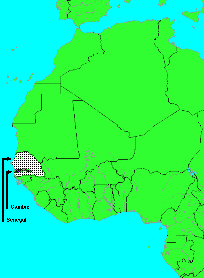
Senegal and Gambia
 Français
Français
The number of tumuli made of earth or sand in Senegal comes to 6,868, spread across 1444 sites. To this can be added the 3448 tumuli of the megalithic type, and 903 more tumuli made of shells.
This large distribution does not constitute an homogenous phenomenon. The 14C dates gathered from the excavated sites in Sine and Saloum, or in the middle Senegal valley, do not show chronological opposition. According to the the present state of the research, the Senegambian tumuli are dated from the first two millennia of our era - more precisely from the Fourth until Twentieth centuries AD. Thanks to historical accounts we know that the Sereer have built up burial tumuli in this region since at least the 16th century.
Knowledge of the Senegambian tumuli is very limited. Anthropology and history may help us to pose certain questions. This study is the first stage of a differentiation of ceramic cultures between the ethnic groups which inhabited Senegambia. The Sine and Saloum seems to be a key sector in the understanding of the phenomenon of the Senegambian tumuli.
This paper is in French only.
Go to the Table of Contents